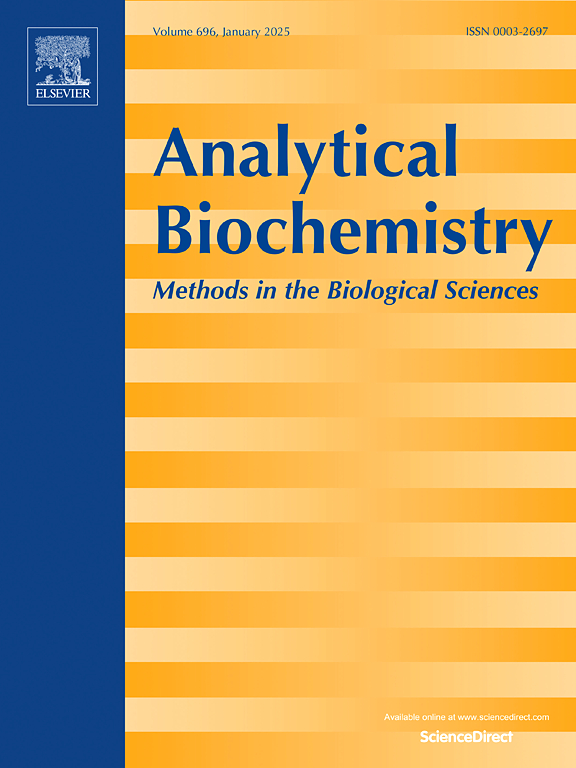Development of radioligand binding assays for REV-ERBα and REV-ERBβ
IF 2.5
4区 生物学
Q2 BIOCHEMICAL RESEARCH METHODS
引用次数: 0
Abstract
REV-ERBα and REV-ERBβ are atypical nuclear receptors that function as ligand-dependent repressors of transcription. They play critical roles in the regulation of the circadian rhythm, inflammation, and metabolism. The natural ligand for the REV-ERBs is heme, and synthetic ligands (both agonists and antagonists) have been designed and utilized to probe the potential clinical utility of targeting REV-ERBs for drug development. Although biochemical assays that can detect REV-ERB ligands have been developed based on protein-protein interactions, no classical fluorescent- or radioligand-binding assay has yet been developed that directly detects ligand binding. Here, we describe the development of the first radioligand binding assay (RLBA) using scintillation proximity assay (SPA) technology for both REV-ERBα and REV-ERBβ using labeled STL1267, a potent REV-ERBα/β agonist we recently described. 3H-STL1267 displayed saturable binding to the ligand binding domains of both REV-ERBα and REV-ERBβ with equilibrium dissociation constants (Kds) of 392 nM and 202 nM, respectively. In competition radioligand binding assays, we used unlabeled STL1267 or the well-characterized first-generation REV-ERB agonist SR9009 as competitors to 3H-STL1267 binding. STL1267 displayed Kis for REV-ERBα and REV-ERBβ of 253 ± 30 nM and 98 ± 14 nM, respectively. As expected, SR9009 displayed considerably lower potency than STL1267, with a Ki of 692 ± 209 nM for REV-ERBα and 2546 ± 127 nM for REV-ERBβ. Although developing an RLBA has been challenging due to the lack of high-affinity ligands that can be used as probes, our results demonstrate the feasibility of such an assay for both receptors, providing a robust assay with utility for ligand/drug discovery.

rev - erba和rev - erbb β放射配体结合试验的建立。
REV-ERBα和REV-ERBβ是不典型的核受体,作为配体依赖的转录抑制因子。它们在调节昼夜节律、炎症和新陈代谢方面发挥着关键作用。rev - erb的天然配体是血红素,合成配体(激动剂和拮抗剂)已被设计和利用,以探索靶向rev - erb的药物开发的潜在临床效用。尽管基于蛋白质-蛋白质相互作用已经开发出了能够检测REV-ERB配体的生化分析方法,但还没有开发出直接检测配体结合的经典荧光或放射配体结合分析方法。在这里,我们描述了使用闪烁接近试验(SPA)技术对rev - erba α和rev - erbb β使用标记STL1267(我们最近描述的一种有效的rev - erba α/β激动剂)开发的第一个放射性配体结合试验(RLBA)。3H-STL1267与rev - erba α和rev - erbb β的配体结合域均表现出饱和结合,平衡解离常数(Kds)分别为392 nM和202 nM。在竞争放射性配体结合试验中,我们使用未标记的STL1267或特性良好的第一代REV-ERB激动剂SR9009作为3H-STL1267结合的竞争对手。STL1267对rev - erbb α和rev - erbb β分别在253±30 nM和98±14 nM处显示Kis。结果表明,SR9009的效价明显低于STL1267,对rev - erbb α和rev - erbb β的Ki值分别为692±209 nM和2546±127 nM。尽管由于缺乏可用作探针的高亲和力配体,开发RLBA一直具有挑战性,但我们的研究结果证明了这种检测两种受体的可行性,为配体/药物发现提供了一种强大的检测方法。
本文章由计算机程序翻译,如有差异,请以英文原文为准。
求助全文
约1分钟内获得全文
求助全文
来源期刊

Analytical biochemistry
生物-分析化学
CiteScore
5.70
自引率
0.00%
发文量
283
审稿时长
44 days
期刊介绍:
The journal''s title Analytical Biochemistry: Methods in the Biological Sciences declares its broad scope: methods for the basic biological sciences that include biochemistry, molecular genetics, cell biology, proteomics, immunology, bioinformatics and wherever the frontiers of research take the field.
The emphasis is on methods from the strictly analytical to the more preparative that would include novel approaches to protein purification as well as improvements in cell and organ culture. The actual techniques are equally inclusive ranging from aptamers to zymology.
The journal has been particularly active in:
-Analytical techniques for biological molecules-
Aptamer selection and utilization-
Biosensors-
Chromatography-
Cloning, sequencing and mutagenesis-
Electrochemical methods-
Electrophoresis-
Enzyme characterization methods-
Immunological approaches-
Mass spectrometry of proteins and nucleic acids-
Metabolomics-
Nano level techniques-
Optical spectroscopy in all its forms.
The journal is reluctant to include most drug and strictly clinical studies as there are more suitable publication platforms for these types of papers.
 求助内容:
求助内容: 应助结果提醒方式:
应助结果提醒方式:


